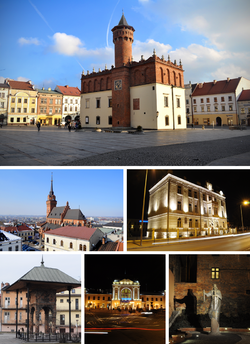Tarnów
| Tarnów | |||
|---|---|---|---|

|
|||
|
|||
| Coordinates: 50°00′45″N 20°59′19″E / 50.01250°N 20.98861°E | |||
| Country | Poland | ||
| Voivodeship | Lesser Poland | ||
| County | city county | ||
| Town rights | 7 March 1330 | ||
| Government | |||
| • President | Roman Ciepiela | ||
| Area | |||
| • City | 72.4 km2 (28.0 sq mi) | ||
| Population (2013) | |||
| • City | 112,478 | ||
| • Density | 1,600/km2 (4,000/sq mi) | ||
| • Metro | 269,000 | ||
| Time zone | CET (UTC+1) | ||
| • Summer (DST) | CEST (UTC+2) | ||
| Postal code | 33-100 to 33-110 | ||
| Area code(s) | +48 14 | ||
| Car plates | KT | ||
| Website | http://www.tarnow.pl | ||
Tarnów (Polish pronunciation: [ˈtarnuf]; German: Tarnau; Yiddish: טאָרנע, Torne) is a city in southeastern Poland with 115,341 inhabitants as of June 2009 (metro area 269,000 inhabitants). The city is situated in the Lesser Poland Voivodeship since 1999. From 1975 to 1998, it was the capital of the Tarnów Voivodeship. It is a major rail junction, located on the strategic east-west connection from Lviv to Kraków. Also from Tarnów two additional lines depart: a southward railway line to the Slovak border via Stróże, as well as a minor northward line to Szczucin (now defunct).
Tarnów lies at the Carpathian foothills, on the Dunajec and the Biała rivers. The area of the city is 72.4 square kilometres (28.0 sq mi). It is divided into sixteen districts, known in Polish as osiedla. A few kilometers west of the city lies the district of Mościce, built in the late 1920s, together with a large chemical plant. The district was named after President of Poland, Ignacy Mościcki.
The first documented mention of the settlement dates back to 1105, spelled as Tharnow. The name later evolved to Tarnowo (1229), Tarnów (1327), and Tharnow (1473). The place name, Tarnów, is widely used in different forms across Slavic Europe, and lands which used to be inhabited by Slavs, such as eastern Germany, Hungary, and northern Greece. There is a German town, Tarnow, Greek Tyrnavos (also spelled as Tirnovo), Czech Trnov, Bulgarian Veliko Tarnovo and Malko Tarnovo, as well as different Trnovos/Trnowos in Slovenia, Slovakia, Serbia, Bosnia, and Macedonia. The name Tarnów comes from an early Slavic word trn/tarn, which means a thorn, or an area covered by thorny plants.
...
Wikipedia



